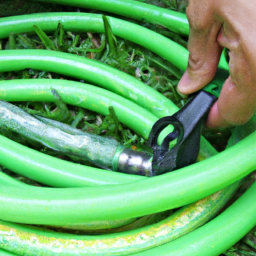How To Cut A Garden Hose A Guide
Table of Contents []
How To Cut A Garden Hose
Introduction
Garden hoses are a versatile and valuable tool for gardeners and landscapers. It's important to know the ins and outs of how to use them correctly to avoid costly and time-consuming mistakes. This article will provide an in-depth look at the necessary steps for how to cut a garden hose, from identifying the right tool for the job to the different ways to cut a garden hose. We'll include popular subtopics for a deeper understanding on this page, such as choosing an appropriate garden hose cutter, recommended garden hose cutting tools, and understanding garden hose end fittings. Finally, we will end with a brief summary of this article.
H2: Choosing an Appropriate Garden Hose Cutter
The first step in cutting a garden hose is to select the proper cutter. Garden hose cutters are specially designed to cut through common varieties of plastic and rubber hoses quickly, cleanly, and efficiently. They come in both manual and power operated versions of various sizes. Many gardeners choose manual models, as they typically are less expensive and easier to use. The manual models have a hardened steel cutter to help ensure that the hose is cut evenly and cleanly.
H3: Manual Garden Hose Cutters
Manual garden hose cutters are available in several sizes and configurations. Most are designed with a spring-loaded lever which helps facilitate an even cut along the hose. Typically, the user places the cutting edge of the cutter against the hose and presses the lever to make the cut. It is important to note that most manual garden hose cutters are designed for hoses under one inch in diameter, so larger sizes may require a powered model.
H3: Powered Garden Hose Cutters
For larger hoses, a powered garden hose cutter is the best option. These are often hand-held models with a rotating blade which is powered by electricity, compressed air, or gasoline. They are much more efficient than manual garden hose cutters and can easily cut through thick rubber and plastic hoses. They are ideal for professional applications, as they can cut through heavy-duty hoses quickly and efficiently.
H2: Recommended Garden Hose Cutting Tools
For gardeners looking for a lighter-duty garden hose cutting tool, there are several options. A utility knife is an affordable and versatile cutting tool that is ideal for small hoses. Simply slide the blade along the length of the hose and apply firm pressure to cut the hose. While not as precise as a garden hose cutter, a utility knife can still be used to make clean and even cuts in hoses up to one inch in diameter.
H3: Garden Shears
Garden shears are another popular garden hose cutting tool. They are generally designed for small and thin-walled hoses, and provide a clean and easy cut. They also come in sizes suitable for larger hoses and are often easier to use than a garden hose cutter.
H2: Understanding Garden Hose End Fittings
Garden hoses typically come with one or two end fittings. These are typically brass and usually come in several different sizes to fit the different types of faucets and couplers. All garden hoses have either male or female ends, and it is important to be aware when cutting the hose of which end is male and which end is female.
H3: Standard Male vs. Female Fittings
Standard male end fittings are designed to fit inside a female fitting, and are most commonly found on spigots and couplers. Female end fittings are designed to fit over a male end, and are most commonly found on taps and hoses. When cutting the hose, it is especially important to know which end is male and which is female in order to ensure a proper fit.
H3: Specialty Fittings
Some hoses come with specialty fittings which should be handled with caution when cutting. Specialty fittings include quick-connect and barbed fittings, which require special care when handling and cutting. It is important to make sure the hose is cut cleanly and evenly so that the specialty fitting fits properly after cutting.
Summary
In conclusion, cutting a garden hose correctly can help avoid costly mistakes. This article provides an in-depth look at the necessary steps for how to cut a garden hose. By following the steps outlined here, gardeners can select the right cutter and cutting tool, as well as understand the different types of garden hose end fittings. With the information gathered here, gardeners can safely and effectively cut a garden hose.

Previous Page
Next Page
